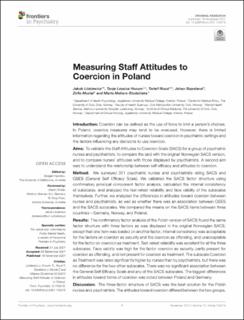| dc.contributor.author | Lickiewicz, Jakub | |
| dc.contributor.author | Husum, Tonje Lossius | |
| dc.contributor.author | Ruud, Torleif | |
| dc.contributor.author | Siqveland, Johan | |
| dc.contributor.author | Musiał, Zofia | |
| dc.contributor.author | Makara-Studzińska, Marta | |
| dc.coverage.spatial | Poland | en_US |
| dc.date.accessioned | 2022-03-17T14:05:30Z | |
| dc.date.available | 2022-03-17T14:05:30Z | |
| dc.date.created | 2021-12-16T11:53:54Z | |
| dc.date.issued | 2021-11-16 | |
| dc.identifier.citation | Frontiers in Psychiatry. 2021, 12 . | en_US |
| dc.identifier.issn | 1664-0640 | |
| dc.identifier.uri | https://hdl.handle.net/11250/2985916 | |
| dc.description.abstract | Introduction: Coercion can be defined as the use of force to limit a person’s choices. In Poland, coercive measures may tend to be overused. However, there is limited information regarding the attitudes of nurses toward coercion in psychiatric settings and the factors influencing any decisions to use coercion.
Aims: To validate the Staff Attitudes to Coercion Scale (SACS) for a group of psychiatric nurses and psychiatrists, to compare the said with the original Norwegian SACS version, and to compare nurses’ attitudes with those displayed by psychiatrists. A second aim was to understand the relationship between self-efficacy and attitudes to coercion.
Method: We surveyed 351 psychiatric nurses and psychiatrists rating SACS and GSES (General Self Efficacy Scale). We validated the SACS factor structure using confirmatory principal component factor analysis, calculated the internal consistency of subscales, and analyzed the test-retest reliability and face validity of the subscales themselves. Further, we analyzed the differences in attitudes toward coercion between nurses and psychiatrists, as well as whether there was an association between GSES and the SACS subscales. We compared the means on the SACS items between three countries—Germany, Norway, and Poland.
Results: The confirmatory factor analysis of the Polish version of SACS found the same factor structure with three factors as was displayed in the original Norwegian SACS, except that one item was loaded on another factor. Internal consistency was acceptable for the factors on coercion as security and the coercion as offending, and unacceptable for the factor on coercion as treatment. Test-retest reliability was excellent for all the three subscales. Face validity was high for the factor coercion as security, partly present for coercion as offending, and not present for coercion as treatment. The subscale Coercion as Treatment was rated significantly higher by nurses than by psychiatrists, but there was no difference for the two other subscales. There was no significant association between the General Self-Efficacy Scale and any of the SACS subscales. The biggest differences in attitudes toward forms of coercion was noted between Poland and Germany.
Discussion: The three-factor structure of SACS was the best solution for the Polish nurses and psychiatrists. The attitudes toward coercion differed between the two groups, but a low correlation was computed for the SACS subscales and self-efficacy. There is a cultural diversity visible amongst the three countries examined. Reduction in the use of coercion is a priority worldwide. More knowledge about the process involved in using coercive measures may contribute to this. The use of coercive interventions may harm patients and threaten patients’ rights. Thus, education is needed for pre-service and in-service nurses alike. | en_US |
| dc.description.sponsorship | This research was a part of the project Adaptation of tools used by medical personnel for measure of aggressive behaviors funded by Ministry of Science of Republic of Poland (no. 43/DBS/000066) | en_US |
| dc.language.iso | eng | en_US |
| dc.publisher | Frontiers Media | en_US |
| dc.relation.ispartofseries | Frontiers in Psychiatry;November 2021 | Volume 12 | Article 745215 | |
| dc.rights | Navngivelse 4.0 Internasjonal | * |
| dc.rights.uri | http://creativecommons.org/licenses/by/4.0/deed.no | * |
| dc.subject | Mental health | en_US |
| dc.subject | Staff | en_US |
| dc.subject | Attitudes | en_US |
| dc.subject | Coercion | en_US |
| dc.subject | Psychometrics | en_US |
| dc.title | Measuring Staff Attitudes to Coercion in Poland | en_US |
| dc.type | Peer reviewed | en_US |
| dc.type | Journal article | en_US |
| dc.description.version | publishedVersion | en_US |
| dc.rights.holder | © 2021 Lickiewicz, Husum, Ruud, Siqveland, Musiał and Makara-Studzińska | en_US |
| dc.source.articlenumber | 745215 | en_US |
| cristin.ispublished | true | |
| cristin.fulltext | original | |
| cristin.qualitycode | 1 | |
| dc.identifier.doi | https://doi.org/10.3389/fpsyt.2021.745215 | |
| dc.identifier.cristin | 1969378 | |
| dc.source.journal | Frontiers in Psychiatry | en_US |
| dc.source.volume | 12 | en_US |
| dc.source.issue | 12 | en_US |
| dc.source.pagenumber | 1-10 | en_US |
| dc.relation.project | Ministerstwo Edukacji i Ministerstwo Edukacji i Nauki: 43/DBS/000066 | en_US |

